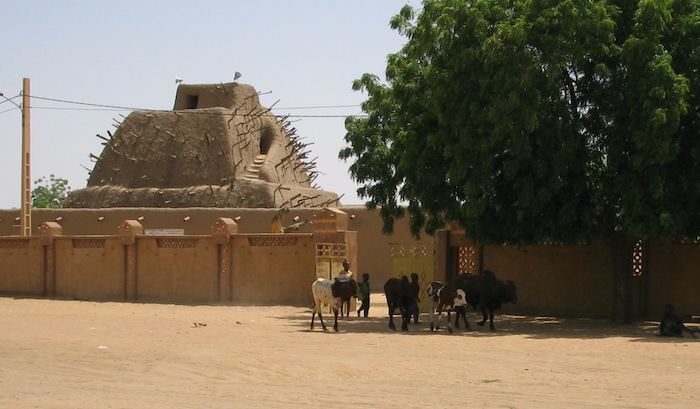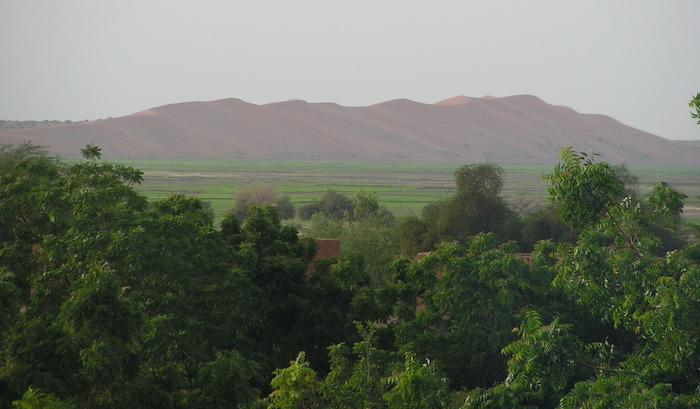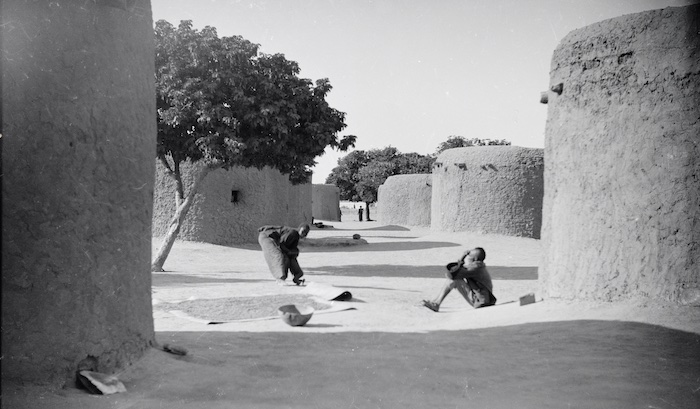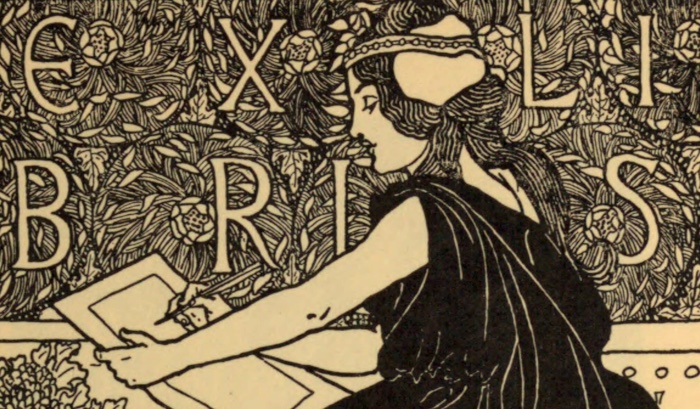The Epic of Askia Muhammad recounts many important events in the history of the Songhai people of Niger and Mali. It’s a long song – it takes hours to sing – and it has sections in multiple languages. Among other stories, it tells the tale of a terrible turmoil in a Songhai noble family and how this hatred led to the destruction of the city of Gao by Moroccan soldiers. Both this really cool story and the really interesting reason for the shifting language make great inspirations for RPG adventures!
This post is brought to you by beloved Patreon backer Joel Dalenberg. Thanks for helping keep the lights on! If you want to help keep this blog going alongside Joel, head over to the Patreon page – and thank you!

Image credit: Ryszard Vorbrich. Released under a CC BY-SA 3.0 PL license.
The Songhai people historically live in the West African Sahel – the arid scrubland that lies between the Sahara and the green lands to the south. They founded an empire in the 1460s that absorbed much of the old Mali Empire. The Songhai Empire had its capitol at Gao, along the Niger river in modern Mali, and also included the famous towns of Timbuktu and Djenné. Songhai rulers were a mixed bag. The empire’s founder, Sunni Ali, was famous for burning manuscripts and executing scholars. But his successor’s successor, the Askia Muhammad of the eponymous epic, was famously supportive of scholarship, and the old cities of the Songhai Empire are still centers of learning in the Sahel.
We’re going to look at events in the Epic of Askia Muhammad long after the death of its titular hero. These events surround Soumayla Kassa, who was chief at Gao around 1630-1640. By this point, the Songhai Empire mostly didn’t exist. Forty years earlier, a Moroccan military expedition conquered Gao, but was unable to hold it. They did succeed at establishing a client state at Timbuktu, where the descendants of those Moroccan soldiers became known as their own ethnic group (the Arma) and still live in Timbuktu today. Soumayla Kassa, chief of Gao, was a Songhai ruler of an at least partially Songhai state, but the degree to which he was independent of Morocco and the Arma rulers of Timbuktu is an interesting question. In any case, the events described in The Epic of Askia Muhammad likely conflate multiple incidents that occurred over the course of the Moroccan conquest and occupation.

Image credit: David Sessoms from Fribourg, Switzerland. Released under a CC BY-SA 2.0 license.
Around the time the old chief died, Soumayla Kassa came to Gao. He married two women. The first was a captive owned by the old chief’s family. People captured in war existed in a state of hereditary servility, though this was not slavery in the American/Brazilian/Caribbean model. Soumayla Kassa did not bother to free this wife. He was busy marrying his second wife: the old chief’s daughter, Sagouma. Through this union, Soumayla Kassa became the new chief. Sagouma had a brother (the old chief’s son) who might have been chief if Soumayla Kassa hadn’t shown up. Instead, he remained in his father’s compound in a state of poverty. Both of Soumayla Kassa’s wives gave birth. The captive wife brought forth a son, Amar Zoumbani. The noble wife had twin sons. Time passed.
When Amar Zoumbani came of age, there was in Gao a beautiful, rich, single woman. All the young men of Gao courted her. Her house was full of griots – the hereditary bards of West Africa. They sang praise songs to honor her and any of her suitors who gave them gifts. Amar Zoumbani gave the griots ten horses. They sang and sang to honor the prince who’d given them such a grand gift. This made the other suitors look bad and angered them. Chief among them was Sagouma’s brother. So he shamed Amar Zoumbani. He took the young prince by the wrist and gave him as a gift to the griots. Was he not born to a captive woman owned by Sagouma’s family? Did the suitor not have the right to do so? This was a symbolic gesture; for all that he was born of a lowly mother, Amar Zoumbani was a prince and could not be given away. But it was incredibly insulting and Amar Zoumbani ran home to cry. He’d never really thought about what it meant that his father hadn’t bothered to free his mother before he was born.
Amar Zoumbani grew jealous of Sagouma’s brother. The older man owned a horse that was pure black. It had not a speck of white on it anywhere. Amar Zoumbani wanted a horse just like that one. So Chief Soumayla Kassa sent his servants out to the hinterlands to find such a horse. They searched and searched to no avail. So they took the blackest horse with the least white and rubbed indigo on its white patches to conceal them, then presented the horse to Soumayla Kassa and Amar Zoumbani.

Image credit: KAG1LP2MDIAKITE. Released under a CC BY-SA 4.0 license.
Amar Zoumbani wanted to ride the horse to public prayers so everyone would see it. Soumayla Kassa was afraid his son would bump into his older rival at the prayer ground (the word ‘mosque’ is not used here in the text), and the two would see each other on their identical horses and throw spears at one another. So at prayer-time the chief sent servants to summon his brother-in-law to him for a quick and meaningless meeting. Amar Zoumbani rode to prayer and everyone saw he had the finest horse there.
On the way back from prayer, the horse was sweaty. The sweat made the indigo run, revealing the servants’ half-measures and ruining Amar Zoumbani’s white clothes. The prince had a griot with him. The bard tried to flatter his master to make him feel better. But he couldn’t refrain from speaking the truth in a way he thought covert. The bard switched languages from Songhai to Soninke and said, “Although they say this is a black horse, it is really a white horse.” Amar Zoumbani spoke Soninke and understood the truth of what everyone else could see. He grew wroth. He leapt from his horse, drew his sword, and killed the animal.

Image credit: Ministère de l’Europe et des Affaires étrangères. Released under a CC BY 3.0 license.
This is a great time to talk about the language of The Epic of Askia Muhammad. Most of it is in Songhai. But in prior centuries the oral traditions of the Songhai people were maintained in the language of the Soninke, a people who overlap geographically with the Songhai. So while most of the Epic of Askia Muhammad is in Songhai, some lines are still in Soninke. But this isn’t modern Soninke, as spoken in Soninke communities today. Languages evolve over time. So in the centuries since the Epic was composed in Soninke, the language as used by Soninke people has evolved away from that form – and the Soninke language as used by Songhai keepers of oral tradition has also evolved in its own different direction. These two dialects are now different enough that much of the Songhai oral tradition in Soninke cannot actually be understood by Soninke people.
The result is a sort of liturgical language, a little like Latin in the Catholic Church. But the Songhai oral tradition is bigger than the songs of griots. It also encompasses the recitations used by sorcerers, traditional healers, and spirit intercessors, who all use this semi-secret language. Anthropologist Paul Stoller trained under Songhai sorcerers. He records the use of “untranslatable” special names and phrases embedded in spells that were otherwise performed in the Songhai language. He speculates they were taken from another language but was unable to recognize which. When he pressed his teachers for more information, they told him the words held special power but declined to explain further. This was presumably the semi-secret version of Soninke.
I’d really love to know the extent to which these words, phrases, and lines in songs still constitute an actual living language. When a griot or sorcerer recites them, are they speaking a language? Or are they repeating memorized mouth noises like a five-year-old reciting a Latin prayer? It’s clear that when a griot lapses for a few lines out of Songhai and into the semi-secret language, his audience doesn’t understand what he’s saying. But what about him? Can master griots, healers, and sorcerers carry on a conversation in the language? Stoller’s sorcerous teachers were cagey. Nouhou Malio, the respected griot whose recounting of the Epic of Askia Muhammad was recorded, died after the recording and can thus answer no questions. In past posts, I’ve bemoaned how underrepresented the Sahel is in English-language sources. I’ll add another entry on my list of ‘wouldn’t it be nice to know’.

Image credit: Exereo (Jonathon Hicks). Released under a CC BY 3.0 license.
Chief Soumayla Kassa had enough. He wasn’t angry at his petulant son, but at his brother-in-law, whom he blamed for all these troubles. He ordered a hole dug behind his house, covered it with a grass mat, then concealed it under loose sand. He summoned his brother-in-law to meet him behind the chief’s house. The brother-in-law fell in the hole, and Soumayla Kassa ordered it filled in. He had his wife’s brother buried alive.
A captive leatherworker belonging to the family of Queen Sagouma and her slain brother saw the whole thing through a window. She ran to tell Sagouma. The queen reacted to this betrayal of her family by betraying her husband’s family. She killed her twin sons. She picked them up by the ankles and smashed their heads agains the wall. She left Gao.
For seven years, Sagouma wandered in the bush. She went to the Arma, the Moroccan descendants who ruled in Timbuktu and elsewhere. Every time she met a brave soldier, she offered to marry him – but demanded as her dowry the deaths of Soumayla Kassa and Amar Zoumbani. Sagouma was beautiful, but her husband and his son were fearsome and none would do it – until she met an Arma named Bayero.
Bayero agreed to go to war with Gao. He summoned support from the rich men, from the chiefs, from the marabouts (wandering Islamic scholars), and from the women. This is a curious detail for a Songhai epic to include, since it implies the war against Soumayla Kassa was popular. Bayero’s army marched on Gao and sent seven months besieging it.

But Gao had supernatural protection. Over seven months of siege, nothing happened. Gao barely noticed it was under attack. Every day, Bayero’s army slew ten thousand Gaoan horses, and every night ten thousand horses reappeared in the city. The spirits of a python, a black hen, and a black ox lived near Gao and watched over it. Every day, they made the city levitate into the air while making it seem like it hadn’t moved. So when the Arma fired their cannons and muskets at where they thought Gao was, they struck only the earth beneath it. This lasted until a Songhai lover of one of the Arma soldiers told her beau the secret of the city’s protection. Then the Arma fired in the air above Gao and the city was destroyed.
The Songhai fought a rearguard action, moving the city’s entire population downriver. The python, hen, and ox went with them. Queen Sagouma saw the ruins of Gao, where her father’s compound and her mother’s compound had been destroyed by the guns of her allies, and she regretted her decisions. She turned to Bayero, her lover, who had been pressing to fight Soumayla Kassa one-on-one. She agreed to give him what he asked for. She pulled out her godji, her single-stringed fiddle, and played a tune. She sang a song that the epic’s translators were unable to decipher, suggesting that it was in the semi-secret Soninke variant used by sorcerers. It summoned Soumayla Kassa to her, praised him, and helped him kill Bayero. Eventually the Songhai, with help from their allies the Zarma, defeated the Arma and rebuilt Gao.

I’ve written in the past about how useful it can be sometimes to frame your game prep notes as “Here’s what will happen if the PCs don’t do anything.” That’s what the above tale is. It’s a warning of the disastrous outcome this family argument will have if permitted to run its course.
If your PCs have a patron, you can model the patron’s family relationships on those of Soumayla Kassa and Sagouma. The patron can assign PCs tasks that put them in the thick of your fictional family’s quarrel. Examples from the Epic include ‘find Amar Zoumbani a horse’, ‘bring word to the brother-in-law that Soumayla Kassa wants to talk to him at prayer time’, ‘escort Amar Zoumbani home while his horse sweats’, and ‘dig a hole to kill the brother-in-law’. This gives the PCs lots of opportunities to intervene and steer this feud in a direction that won’t end in tragedy. Since you know how the story ends without the party’s changes, you can extrapolate from the changes they make to improvise the new outcome.
The business can be made a little more complicated if most of the major players speak a semi-secret language of power. That’s not too much of a stretch; Sagouma ensorcelled her husband at the end and Amar Zoumbani understood his griot. Once tensions get hot, your fictional major players might communicate with one another by sending messages written in pseudo-Soninke. When the PCs are asked to deliver the messages, they should have a niggling fear that they’re patsies delivering a written curse – and will be blamed when the recipient falls dead at their feet. Naturally, universal translators and spells of comprehend languages won’t work on this language. The PCs could take the message to a fictional Soninke-analogue friend of theirs to verify its contents. But there’s no guarantee the friend will be able to parse the language and if the message is a written curse, it will fall upon the party’s poor friend!
Independent of the family drama, we can pull a cool adventure hook from this language business. Lets say your PCs have finally found the book that contains the information they need to resolve your plot. They can’t read it, and comprehend languages or universal translators are delivering garbled results. So they take it to a scholar who says “That’s weird. It looks like Soninke (or whatever works in your setting), but a lot of the words are wrong. I’ve heard about this obscure semi-secret dialect used by a neighboring non-Soninke people. Try asking them.” When the party gets there, everyone agrees the book is written in that language, but only a handful of masters actually speak the language. Naturally, they live way out in the wilderness and earning their trust will be difficult and dangerous.

Looking for material for your game tonight? My back catalog has hundreds of great posts, all searchable and filterable so you can find something from real history or folklore that fits exactly what you need! Posts older than a year are behind a very cheap paywall – only $2/month!
Sources:
The Epic of Askia Muhammad, edited and translated by Thomas A. Hale (1996) and recounted by Nouhou Malio (1981)
In Sorcery’s Shadow by Paul Stoller and Cheryl Olkes (1987)
From the Griot of Roots to the Roots of Griot: A New Look at the Origins of a Controversial African Term for Bard by Thomas A. Hale (1997)






